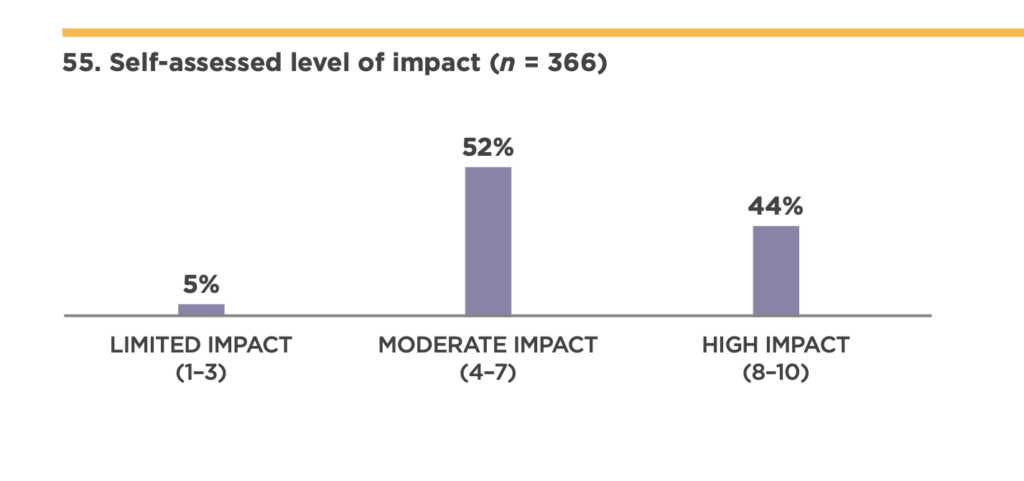
As foundations strive to make meaningful change in support of their missions, understanding what leads to philanthropic impact is crucial. In the 2023 Foundation Operations and Management Report, foundations named insufficient grantmaking impact as one of their top challenges. In this blog, I’ll discuss a few factors that drive impact, as well as strategies for increasing it.
Philanthropic Impact: A Moderate Assessment
In the 2023 FOMR, foundations rated their impact in the community on a scale from 1 (no impact) to 10 (substantial impact). On average, foundations assessed their impact as moderate, with 52% of respondents rating their impact between 4 and 7 (with an average response of 7).

Factors That Drive Impact
Upon deeper analysis, we identified several key factors that influenced how foundations assessed their impact in the community. These factors included:
1. Focused Grantmaking: Foundations that had highly focused grantmaking reported a higher level of impact compared to foundations with unfocused or loosely focused grantmaking strategies. This suggests that a strategic and targeted approach to grantmaking can amplify impact.
2. Incorporating Racial Equity: Foundations that said racial equity was highly relevant to their mission tended to report a higher level of impact compared to foundations that said racial equity was not relevant or only somewhat relevant to their mission. This highlights the importance of incorporating a racial equity lens in foundation work to achieve meaningful and lasting impact.
Strategies for Increasing Impact
Contrary to popular belief, the size of a foundation (in assets and staff) does not entirely determine its impact. What’s more, foundations of any size can implement strategies to increase their impact. Members responding to the survey emphasized many aspects of Catalytic Leadership in Philanthropy (CLIP). Some of the strategies highlighted by funders include:
Having a Focus
Foundations with a tightly focused approach to their grantmaking reported higher impact. A funder said, “Our impact is high because our focus is very tight.” Several funders cited lack of focus as a reason for limited impact. Having a focus lets foundations direct their resources in targeted areas to achieve greater impact.
Embracing Equity
Embracing equity is a powerful strategy for driving impact. For some, this could mean incorporating equity into the foundation’s convening approach to help train nonprofits around equity topics. One foundation said it hosts a network of nonprofits in the area to support capacity-building, networking, civic engagement, and equity work. All of this adds value to their grant funding.
Other foundations have race equity baked into their missions. One said:
“We have defined race equity for the foundation as a future condition where one’s race identity has no influence on how one fares in society. To create an inclusive environment where each person can show up as their full self, feel welcome, respected, and valued to participate fully. Our work and assessment of our work is rooted in race, equity, and inclusion. We established race equity outcomes and indicators for accountability.”
Providing Long-Term, Flexible Funding
Achieving impact and creating lasting change often requires sustained efforts over time. Providing long-term, flexible, and supportive funding through general operating support and multiyear grants can help foundations and grantees achieve their goals. Another funder said,
“We focus specifically on providing multi-year, capacity building grants within our issue areas of youth and environment. These grants are meant to help organizations grow and scale, and we see great success with our model.”
Going Beyond the Grant
Foundations can leverage their position and reputation to convene grantees and stakeholders and foster collaboration between nonprofits and government agencies. This goes beyond traditional grantmaking and includes activities such as facilitation, partnerships, and community engagement.
“Convening, facilitating, and partnerships—not just grantmaking—help us create an impact in our community.”
Funders also said providing early support for organizations, especially grassroots efforts, can inspire other funders and donors to support the nonprofit for the long run.
Soliciting Feedback
Collecting and acting on feedback from grantees and community members provides valuable insights for foundations to continuously improve their impact. You can do this through formal meetings, informal conversations, and organized surveys.
Creating strong feedback loops and learning circles fosters mutual learning and understanding. Whether through formal meetings, informal conversations at grantee events, or organized surveys like Exponent Philanthropy’s Grantee and Applicant Perception Survey, collecting feedback can help funders identify their own strengths and weaknesses.
Learn More About the Grantee and Applicant Perception Survey »
Maximizing Philanthropic Impact
Foundations can unlock their full impact by employing focused grantmaking approaches, incorporating racial equity, providing long-term flexible funding, going beyond traditional grantmaking, and actively seeking and acting on feedback. By implementing these Catalytic Leadership in Philanthropy practices, and being intentional in your approach, you can increase your foundation’s impact and bring more positive change to your community or cause.
Learn More About Catalytic Leadership in Philanthropy »
About the Author
Brendan McCormick is the associate director of research and publications at Exponent Philanthropy. He works with members, partners, and staff to develop resources and research on our funder community.
